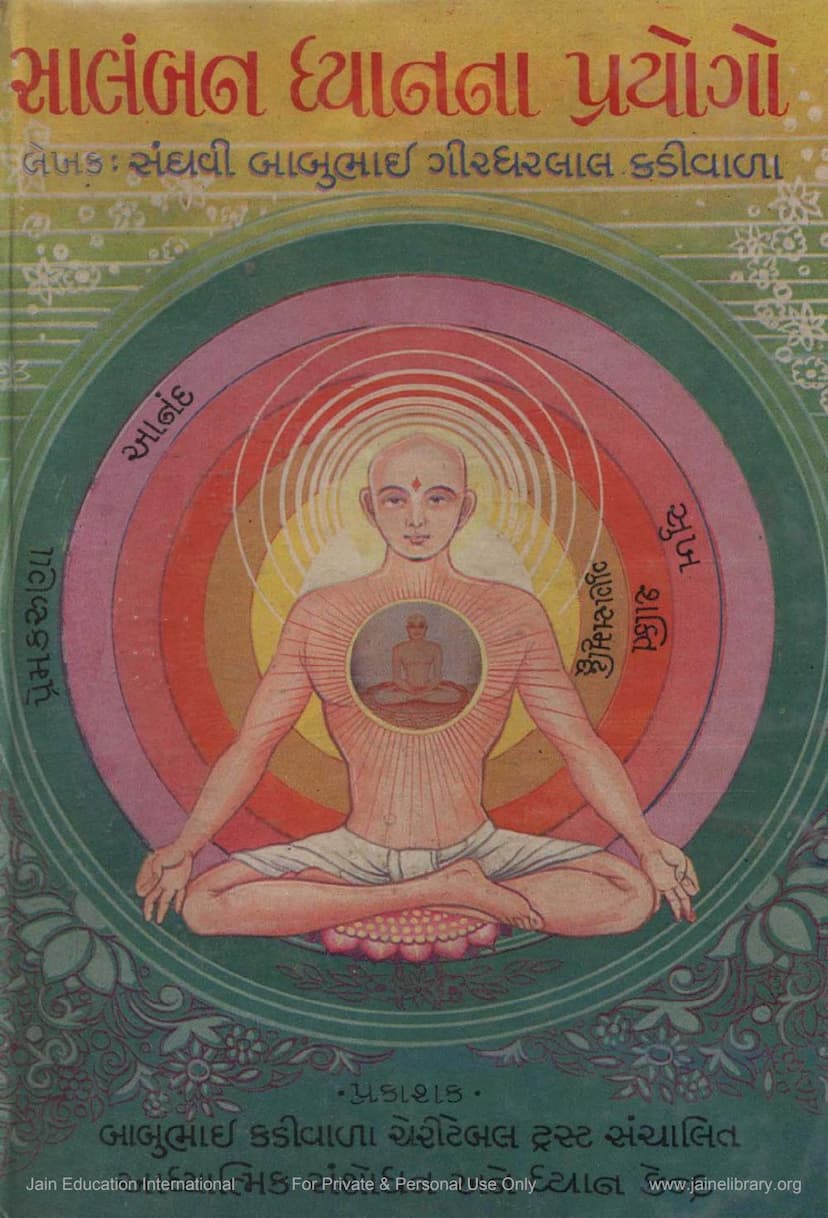Salamban Dhyanana Prayogo
Added to library: September 2, 2025

Summary
Here's a comprehensive summary of the Jain text "Salamban Dhyana Prayogo" by Babubhai Girdharlal Kadiwala, based on the provided pages:
Book Title: Salamban Dhyana Prayogo (Practices of Supported Meditation) Author: Babubhai Girdharlal Kadiwala Publisher: Babubhai Kadiwala Charitable Trust Inspiration/Guidance: Pujya Pandit Shri Bhadrakar Vijayji Maharaj Saheb
Overall Theme:
The book "Salamban Dhyana Prayogo" is a practical guide to Jain meditation techniques, focusing on "supported meditation" (Salamban Dhyana), which involves using a focal point or object for meditation. The primary goal is to achieve inner peace, happiness, spiritual advancement, and ultimately, self-realization and liberation (moksha). The text emphasizes the transformative power of meditation and the importance of connecting with the divine within and the form of the Tirthankaras.
Key Concepts and Content:
-
The Power of Meditation: The book highlights meditation as a profound tool for mental and spiritual well-being. It addresses the prevalent stress and unhappiness in modern life and presents meditation as a solution to find peace, joy, and fearlessness.
-
Salamban Dhyana (Supported Meditation): This is the core concept, meaning meditation with a support or object of focus. The text identifies the Arhant (the perfected soul) as the highest and purest support for meditation. By meditating on the divine qualities and powers of the Paramatma (Supreme Soul), the practitioner can internalize these qualities and become one with them.
-
The Divine Within: The book explains that the Paramatma (Supreme Soul) resides within the practitioner's heart. Through meditation, the divine qualities and powers like love, compassion, joy, strength, and prosperity can manifest and permeate the practitioner's entire being, transforming them into an embodiment of these virtues.
-
Role of the Guru: The author expresses deep gratitude to his spiritual guide, Pujya Pandit Shri Bhadrakar Vijayji Maharaj Saheb, who inspired and guided him for over 23 years. The book is presented as a fruit of this profound spiritual relationship and the teachings received.
-
Practical Meditation Techniques (Prayogs): The book outlines numerous meditation techniques (Prayogs), numbered from 1 onwards. These techniques aim to:
- Overcome Negativity: Release from sorrow, fear, worry, anxiety, and tension, replacing them with happiness, peace, joy, and fearlessness.
- Purify the Mind: Eradicate negative tendencies, bad habits, and sinful inclinations through divine meditation.
- Cultivate Virtues: Develop positive qualities like forgiveness, humility, simplicity, contentment, love, and compassion.
- Connect with the Divine: Experience the presence and union with the Paramatma.
- Achieve Self-Realization: Understand the true nature of the soul and its inherent divine qualities.
- Specific Techniques: The text details various methods, including:
- Focusing on the Paramatma's form: Visualizing the divine being.
- Mantra Meditation: Especially focusing on the Namaskar Mahamantra (Navkar Mantra) and its syllables, exploring its various aspects and benefits.
- Symbolic Meditation: Using diagrams like lotuses, wheels (Chakras), and symbolic representations of the Siddha-chakra.
- Emotional Cultivation: Developing feelings of friendship, compassion, and equanimity towards all beings.
- Mindfulness of Breath: Regulating the breath and associating it with divine names.
-
The Namaskar Mahamantra (Navkar Mantra): The book places significant emphasis on the Navkar Mantra, describing it as the "supreme art of life" and a powerful tool for spiritual progress. It explains how to focus on the letters and syllables of the mantra to achieve concentration and connect with the divine. Various levels of practice, from basic chanting to advanced visualization, are presented.
-
The Significance of Navpad: The nine sacred syllables of the Navkar Mantra (Navpad) are highlighted as the essence of Jain teachings and a primary object of meditation. Their worship and meditation are considered a path to liberation.
-
Siddha-chakra Meditation: The text describes the significance and practice of meditating on the Siddha-chakra in different forms (pot-shaped, wish-fulfilling tree shaped, and circular). It connects the practice to achieving worldly and spiritual prosperity, drawing parallels with the lives of Shripal and Mayana.
-
Anupreksha and Swadhyaya: The book encourages reflection and self-study (Swadhyaya) of scriptures and verses as a form of meditation to understand profound truths and develop spiritual insight.
-
The Concept of "Ideal Reality": The author differentiates between historical reality and "Ideal Reality" – the mental visualization or conceptualization of the divine. He emphasizes that consistent meditation on this Ideal Reality can manifest desired outcomes and spiritual experiences.
-
Practical Guidance: The book offers practical advice on preparing for meditation, including posture, direction, time, and the importance of mental preparation.
-
The Power of Visualization and Intention: The text repeatedly stresses that clear visualization, strong intention, and unwavering faith are crucial for the success of meditation practices. The mind's focus on desires can eventually manifest them.
-
Transformation of Habits: Through consistent meditation, individuals can transform negative habits and thought patterns into positive ones, leading to a renewed life filled with peace, joy, and fearlessness.
-
Personal Experience and Faith: The author shares how the teachings and practices gained from his guru have profoundly impacted his life, leading him to write this book to benefit others. He encourages readers to approach the practices with faith and dedication.
-
Stages of Meditation: The book implicitly suggests a progression in meditation, starting from basic visualization and mantra chanting to more profound states of absorption and identification with the divine.
-
Practical Application: The book's ultimate aim is to enable readers to integrate these meditative practices into their daily lives, leading to a transformed and fulfilling existence. The author believes that consistent practice, combined with faith and the guidance of the teachings, can lead to the realization of one's divine potential.
In essence, "Salamban Dhyana Prayogo" serves as a comprehensive manual for Jain practitioners seeking to deepen their spiritual connection and achieve inner transformation through guided meditation, emphasizing the profound wisdom and practical techniques derived from Jain scriptures and the lineage of respected gurus.